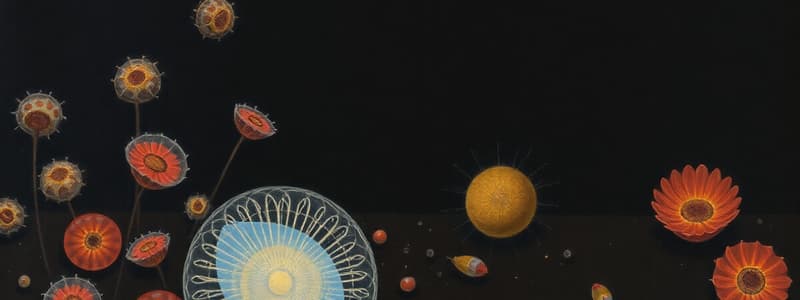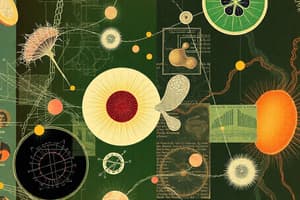Podcast
Questions and Answers
All living things are made up of cells.
All living things are made up of cells.
True (A)
What type of organisms can be unicellular?
What type of organisms can be unicellular?
- Animals
- Fungi
- Bacteria (correct)
- Plants
What is reproduction?
What is reproduction?
Making more of their own kind
Which of the following is NOT a characteristic of life?
Which of the following is NOT a characteristic of life?
All living things require _____ for their metabolic processes.
All living things require _____ for their metabolic processes.
What is homeostasis?
What is homeostasis?
Viruses are considered living organisms.
Viruses are considered living organisms.
What is heredity?
What is heredity?
Which of the following is a biotic factor?
Which of the following is a biotic factor?
Match the following types of pupils with their respective animals:
Match the following types of pupils with their respective animals:
What is an example of a behavioral adaptation?
What is an example of a behavioral adaptation?
Flashcards are hidden until you start studying
Study Notes
Cell Structure and Function
- All living things are composed of cells, which are considered the fundamental unit of life.
- Cells can exist independently, like a single blood cell, or as part of a larger structure such as tissues and organs.
- Single celled organisms are called unicellular, such as bacteria, while organisms made up of multiple cells are called multicellular, such as animals and plants.
Reproduction
- All living organisms have the ability to reproduce, creating more of their own kind.
- Reproduction is essential for the continued existence of a species.
Growth and Development
- All living things increase in size and undergo changes over time, a process known as development.
- All organisms start as a single cell.
- Unicellular organisms like bacteria grow and develop organelles for specific functions.
- Multicellular organisms develop from a single cell that multiplies and differentiates, resulting in specialized cells with distinct functions.
Cell Differentiation
- Plants: Cells differentiate into different types, such as those for transporting water, absorbing water, and absorbing light.
- Animals: A single stem cell can replicate itself or differentiate into various cell types.
Characteristics of Life
- Cellular organization: All living things are composed of cells.
- Reproduction: All living things create more of their own kind.
- Metabolism/Requires Energy: Organisms use chemical reactions to obtain and utilize energy for life processes.
- Homeostasis: Maintaining a stable internal environment; organisms respond to changes in their surroundings and adjust accordingly.
- Heredity: Traits are passed from parents to offspring through genes, the basic units of heredity.
- Responsiveness: All living things react to stimuli.
- Growth and Development: Organisms increase in size and undergo changes over time.
- Adaptations: Inherited characteristics that help organisms survive and reproduce successfully.
Viruses: Not Living Organisms
- Viruses lack certain characteristics of life, making them non-living.
- They cannot reproduce independently and require a host cell to multiply.
- They are not made up of cells and lack the ability to grow and metabolize.
Homeostasis Explained
- Homeostasis ensures the body maintains a stable internal environment essential for proper functioning.
- Examples include regulating blood glucose levels, removing waste products, and maintaining body temperature.
What is Biology?
- The study of life.
- From the Greek words "bio" (life) and "logos" (study of).
Living or Nonliving
- Biotic Factors: Living organisms like bacteria, fungi, plants, protists, and animals.
- Abiotic Factors: Non-living things like water, soil, viruses, sun, rocks, and clouds.
Heredity
- All living organisms pass on traits to their offspring through genes encoded in DNA.
Responsiveness Examples
- Phototropism: growth of plants towards light.
- Phototaxis: movement of organisms towards or away from light.
- Thigmotaxis: response to contact or touch.
- Reflexes: protective responses in animals to avoid harm.
Adaptations: Inherited Changes
- Adaptations are inherited changes that occur over time, helping species survive and pass on their genes.
Eye Adaptation
- Different animals have different pupil shapes, influencing their vision and hunting strategies.
Behavioral Adaptations
-
How an animal acts, categorized as:
Inherited Behaviors
- Migration
- Hibernation
- Being nocturnal
- Defensive behaviors
- Mating or courtship behaviors
Learned Behaviors
- Finding food
- Making a shelter
- Communication
- Social behavior
- Predator avoidance
Physical Adaptations
-
Physical features that evolve over time.
Body Parts
- Types of feet
- Kinds of claws
- Types of mouths and/or beaks
- Kinds of body coverings
Color and Pattern
- Camouflage
- Mimicry
Studying That Suits You
Use AI to generate personalized quizzes and flashcards to suit your learning preferences.



